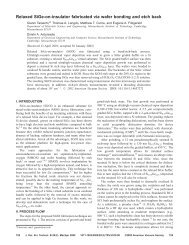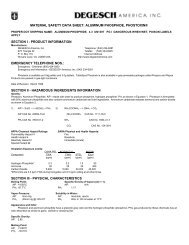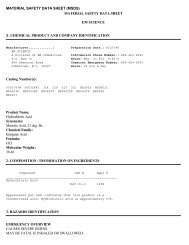Challenges in epitaxial growth of SiGe buffers on Si (111), (110 ...
Challenges in epitaxial growth of SiGe buffers on Si (111), (110 ...
Challenges in epitaxial growth of SiGe buffers on Si (111), (110 ...
- TAGS
- challenges
- epitaxial
- sige
- buffers
Create successful ePaper yourself
Turn your PDF publications into a flip-book with our unique Google optimized e-Paper software.
M.L. Lee et al. / Th<str<strong>on</strong>g>in</str<strong>on</strong>g> Solid Films 508 (2006) 136–139 139higher defect density. Fig. 5 is an XVTEM <str<strong>on</strong>g>of</str<strong>on</strong>g> <strong>Si</strong> 0.75 Ge 0.25grown <strong>on</strong> <strong>Si</strong>(<strong>111</strong>) at 650 -C show<str<strong>on</strong>g>in</str<strong>on</strong>g>g a high density <str<strong>on</strong>g>of</str<strong>on</strong>g> planardefects accompanied by numerous partial dislocati<strong>on</strong>s. Notably,the planar defects (which occur al<strong>on</strong>g <str<strong>on</strong>g>in</str<strong>on</strong>g>cl<str<strong>on</strong>g>in</str<strong>on</strong>g>ed {<strong>111</strong>}-habitplanes) and their associated dislocati<strong>on</strong> cores, are found topenetrate well <str<strong>on</strong>g>in</str<strong>on</strong>g>to the <strong>Si</strong> substrate. The facetted surfaceroughness seen <str<strong>on</strong>g>in</str<strong>on</strong>g> Fig. 5 is caused by surface step bunch<str<strong>on</strong>g>in</str<strong>on</strong>g>gthat arises from a slight <str<strong>on</strong>g>of</str<strong>on</strong>g>fcut <str<strong>on</strong>g>of</str<strong>on</strong>g> the wafer towards an <str<strong>on</strong>g>in</str<strong>on</strong>g>-plane directi<strong>on</strong> [12,13].High-resoluti<strong>on</strong> TEM and selected area diffracti<strong>on</strong> patterns(Fig. 6) reveal that the planar defects <str<strong>on</strong>g>in</str<strong>on</strong>g> Figs. 4 and 5 aremicrotw<str<strong>on</strong>g>in</str<strong>on</strong>g> lamella. A microtw<str<strong>on</strong>g>in</str<strong>on</strong>g> can be formed by the shear<str<strong>on</strong>g>in</str<strong>on</strong>g>gacti<strong>on</strong> <str<strong>on</strong>g>of</str<strong>on</strong>g> numerous partial dislocati<strong>on</strong>s <strong>on</strong> adjacent glide planes[14,15], and gIb c<strong>on</strong>trast analysis d<strong>on</strong>e <str<strong>on</strong>g>in</str<strong>on</strong>g> planar-view dem<strong>on</strong>stratesthat microtw<str<strong>on</strong>g>in</str<strong>on</strong>g>s like the <strong>on</strong>e shown <str<strong>on</strong>g>in</str<strong>on</strong>g> Fig. 6 are composed<str<strong>on</strong>g>of</str<strong>on</strong>g> l<strong>on</strong>g, parallel 90- Shockley partial segments. Thus, thepresence <str<strong>on</strong>g>of</str<strong>on</strong>g> dislocati<strong>on</strong>s deep with<str<strong>on</strong>g>in</str<strong>on</strong>g> the substrate is caused bymutual repulsi<strong>on</strong> between the numerous like-sign dislocati<strong>on</strong>s.The deepest dislocati<strong>on</strong> was probably the 1st dislocati<strong>on</strong>nucleated from the surface, and it was subsequently repelled<str<strong>on</strong>g>in</str<strong>on</strong>g>to the substrate by later-nucleated dislocati<strong>on</strong>s. Therefore, <str<strong>on</strong>g>in</str<strong>on</strong>g><str<strong>on</strong>g><strong>Si</strong>Ge</str<strong>on</strong>g> grown <strong>on</strong> <strong>Si</strong>(<strong>111</strong>) and (<strong>110</strong>), microtw<str<strong>on</strong>g>in</str<strong>on</strong>g>s are formed byrepeated surface nucleati<strong>on</strong> <str<strong>on</strong>g>of</str<strong>on</strong>g> 90- Shockley partials, and not bythe separati<strong>on</strong> <str<strong>on</strong>g>of</str<strong>on</strong>g> pre-exist<str<strong>on</strong>g>in</str<strong>on</strong>g>g 60- dislocati<strong>on</strong>s.4. Discussi<strong>on</strong>The primary problem with compressive films grown <strong>on</strong>(<strong>111</strong>) and (<strong>110</strong>) is that the nucleati<strong>on</strong> and glide <str<strong>on</strong>g>of</str<strong>on</strong>g> 90- Shockleypartials is a significant mechanism for stra<str<strong>on</strong>g>in</str<strong>on</strong>g> relief. For theseorientati<strong>on</strong>s, the glide planes are oriented such that the 90-partial leads and also has a larger Schmid factor than the 60-total dislocati<strong>on</strong> [0.31 vs. 0.27 for (<strong>111</strong>) substrates and 0.47 vs.0.41 for (<strong>110</strong>) substrates]. A 90- Shockley partial dislocati<strong>on</strong>has lower b 2 energy and a relatively larger stra<str<strong>on</strong>g>in</str<strong>on</strong>g>-reliev<str<strong>on</strong>g>in</str<strong>on</strong>g>gcomp<strong>on</strong>ent than a 60- total dislocati<strong>on</strong>, s<str<strong>on</strong>g>in</str<strong>on</strong>g>ce the 90- partialresolves <strong>on</strong>ly <str<strong>on</strong>g>in</str<strong>on</strong>g>to tilt and stra<str<strong>on</strong>g>in</str<strong>on</strong>g>-reliev<str<strong>on</strong>g>in</str<strong>on</strong>g>g comp<strong>on</strong>ents, whilethe 60- total dislocati<strong>on</strong> possesses an additi<strong>on</strong>al screwcomp<strong>on</strong>ent. The higher Schmid factor also means that theactivati<strong>on</strong> energy for nucleati<strong>on</strong> <str<strong>on</strong>g>of</str<strong>on</strong>g> a 90- partial dislocati<strong>on</strong>should be significantly lower than that <str<strong>on</strong>g>of</str<strong>on</strong>g> a 60- totaldislocati<strong>on</strong>. Another situati<strong>on</strong> <str<strong>on</strong>g>in</str<strong>on</strong>g> mismatched heteroepitaxywhere microtw<str<strong>on</strong>g>in</str<strong>on</strong>g>s are frequently encountered is <str<strong>on</strong>g>in</str<strong>on</strong>g> the <str<strong>on</strong>g>growth</str<strong>on</strong>g><str<strong>on</strong>g>of</str<strong>on</strong>g> tensile-stra<str<strong>on</strong>g>in</str<strong>on</strong>g>ed films <strong>on</strong> (001), where, aga<str<strong>on</strong>g>in</str<strong>on</strong>g>, the 90- partialleads [14,15]. S<str<strong>on</strong>g>in</str<strong>on</strong>g>ce microtw<str<strong>on</strong>g>in</str<strong>on</strong>g> defects <str<strong>on</strong>g>in</str<strong>on</strong>g> the films studied hereappear to arrest the glide <str<strong>on</strong>g>of</str<strong>on</strong>g> other dislocati<strong>on</strong>s, the nucleati<strong>on</strong>and propagati<strong>on</strong> <str<strong>on</strong>g>of</str<strong>on</strong>g> planar defects must be avoided <str<strong>on</strong>g>in</str<strong>on</strong>g> order toatta<str<strong>on</strong>g>in</str<strong>on</strong>g> high-quality <str<strong>on</strong>g>epitaxial</str<strong>on</strong>g> materials.While grad<str<strong>on</strong>g>in</str<strong>on</strong>g>g rates <str<strong>on</strong>g>of</str<strong>on</strong>g> 10–20% Ge/Am can be successfullyused for the <str<strong>on</strong>g>growth</str<strong>on</strong>g> <str<strong>on</strong>g>of</str<strong>on</strong>g> low-TDD (001) <str<strong>on</strong>g>buffers</str<strong>on</strong>g>, it is clear thatthe (<strong>111</strong>) and (<strong>110</strong>) substrates cannot tolerate such high stra<str<strong>on</strong>g>in</str<strong>on</strong>g>rates. Still, it rema<str<strong>on</strong>g>in</str<strong>on</strong>g>s possible that high quality films could beatta<str<strong>on</strong>g>in</str<strong>on</strong>g>ed <strong>on</strong> (<strong>111</strong>) or (<strong>110</strong>) wafers by us<str<strong>on</strong>g>in</str<strong>on</strong>g>g extremely slowgrad<str<strong>on</strong>g>in</str<strong>on</strong>g>g rates (e.g. 1% Ge/Am), as has been shown for tensilegraded GaAsP <str<strong>on</strong>g>buffers</str<strong>on</strong>g> <strong>on</strong> GaAs(001) [16]. The appropriategrad<str<strong>on</strong>g>in</str<strong>on</strong>g>g rate for avoid<str<strong>on</strong>g>in</str<strong>on</strong>g>g high TDD <strong>on</strong> (112) substratesprobably lies between that <str<strong>on</strong>g>of</str<strong>on</strong>g> (001) and (<strong>111</strong>)/(<strong>110</strong>).5. C<strong>on</strong>clusi<strong>on</strong>sIn general, low mismatch <str<strong>on</strong>g><strong>Si</strong>Ge</str<strong>on</strong>g> layers grown <strong>on</strong> <strong>Si</strong> (<strong>111</strong>),(<strong>110</strong>) and (112) exhibit TDDs that are >10 higher than thosegrown <strong>on</strong> (001). S<str<strong>on</strong>g>in</str<strong>on</strong>g>ce relaxati<strong>on</strong> processes <strong>on</strong> these substrateorientati<strong>on</strong>s tend to <str<strong>on</strong>g>in</str<strong>on</strong>g>volve the nucleati<strong>on</strong> and glide <str<strong>on</strong>g>of</str<strong>on</strong>g> partialdislocati<strong>on</strong>s and the formati<strong>on</strong> <str<strong>on</strong>g>of</str<strong>on</strong>g> stack<str<strong>on</strong>g>in</str<strong>on</strong>g>g faults and microtw<str<strong>on</strong>g>in</str<strong>on</strong>g>s,achiev<str<strong>on</strong>g>in</str<strong>on</strong>g>g high quality <str<strong>on</strong>g><strong>Si</strong>Ge</str<strong>on</strong>g> buffer layers is <str<strong>on</strong>g>in</str<strong>on</strong>g>tr<str<strong>on</strong>g>in</str<strong>on</strong>g>sicallymore challeng<str<strong>on</strong>g>in</str<strong>on</strong>g>g than <strong>on</strong> (001). Avoid<str<strong>on</strong>g>in</str<strong>on</strong>g>g nucleati<strong>on</strong> <str<strong>on</strong>g>of</str<strong>on</strong>g>stack<str<strong>on</strong>g>in</str<strong>on</strong>g>g faults <str<strong>on</strong>g>in</str<strong>on</strong>g> graded <str<strong>on</strong>g>buffers</str<strong>on</strong>g> <strong>on</strong> (<strong>111</strong>), (<strong>110</strong>) and (112)may require the use <str<strong>on</strong>g>of</str<strong>on</strong>g> stra<str<strong>on</strong>g>in</str<strong>on</strong>g> rates c<strong>on</strong>siderably lower thanthose typically used <strong>on</strong> (001).AcknowledgementsWe gratefully acknowledge fund<str<strong>on</strong>g>in</str<strong>on</strong>g>g from the MARCOMaterials, Structures, and Devices focus center. We also thankC.N. Chlerigh for perform<str<strong>on</strong>g>in</str<strong>on</strong>g>g RBS measurements and S. Guptafor assistance with XRD measurements. This work made use <str<strong>on</strong>g>of</str<strong>on</strong>g>the Shared Experimental Facilities supported by the MRSECProgram <str<strong>on</strong>g>of</str<strong>on</strong>g> the Nati<strong>on</strong>al Science Foundati<strong>on</strong> under awardnumber DMR 02-13282.References[1] S.-i. Takagi, A. Toriumi, M. Iwase, H Tango, IEEE Trans. Electr<strong>on</strong>Devices 41 (1994) 2363.[2] R. Hull, J.C. Bean, Crit. Rev. Solid State Mater. Sci. 17 (1992) 507.[3] M. Yang, E.P. Gusev, M. Ie<strong>on</strong>g, O. Gluschenkov, D.C. Boyd, K.K. Chan,P.M. Kozlowski, C.P. D’Emic, R.M. <strong>Si</strong>c<str<strong>on</strong>g>in</str<strong>on</strong>g>a, P.C. Jamis<strong>on</strong>, A.I. Chou,IEEE Electr<strong>on</strong> Device Lett. 24 (2003) 339.[4] S. Takagi, Symposium <strong>on</strong> VLSI Technology Digest <str<strong>on</strong>g>of</str<strong>on</strong>g> Technical Papers,2003, p. 115.[5] T. Low, M.F. Li, C. Shen, Y.-C. Yeo, Y.T. Hou, C. Zhu, A. Ch<str<strong>on</strong>g>in</str<strong>on</strong>g>, D.L.Kw<strong>on</strong>g, Appl. Phys. Lett. 85 (2004) 2402.[6] S. Thomps<strong>on</strong>, N. Anand, M. Armstr<strong>on</strong>g, C. Auth, B. Arcot, M. Alavi, P.Bai, J. Bielfeld, R. Bigwood, J. Brandenburg, M. Buehler, S. Cea, V.Chikarmane, C. Choi, R. Frankovic, T. Ghani, G. Glass, W. Han, T.H<str<strong>on</strong>g>of</str<strong>on</strong>g>fmann, M. Husse<str<strong>on</strong>g>in</str<strong>on</strong>g>, P. Jacob, A. Ja<str<strong>on</strong>g>in</str<strong>on</strong>g>, C. Jan, S. Joshi, C. Keny<strong>on</strong>, J.Klaus, S. Klopcic, J. Luce, Z. Ma, B. Mc<str<strong>on</strong>g>in</str<strong>on</strong>g>tyre, K. Mistry, A. Murthy, P.Nguyen, H. Pears<strong>on</strong>, T. Sandford, R. Schwe<str<strong>on</strong>g>in</str<strong>on</strong>g>furth, R. Shaheed, S.<strong>Si</strong>vakumar, M. Taylor, B. Tufts, C. Wallace, P. Wang, C. Weber, M. Bohr,Technical Digest—Internati<strong>on</strong>al Electr<strong>on</strong> Devices Meet<str<strong>on</strong>g>in</str<strong>on</strong>g>g, San Francisco,CA, 2002, p. 61.[7] M.L. Lee, E.A. Fitzgerald, M.T. Bulsara, M.T. Currie, A. Lochtefeld,J. Appl. Phys. 97 (2005) 0<strong>111</strong>01.[8] C.W. Leitz, M.T. Currie, A.Y. Kim, J. Lai, E. Robb<str<strong>on</strong>g>in</str<strong>on</strong>g>s, E.A. Fitzgerald,J. Appl. Phys. 90 (2001) 2730.[9] E.P. Kvam, R. Hull, J. Appl. Phys. 73 (1993) 7407.[10] E.A. Fitzgerald, Mater. Sci. Rep. 7 (1991) 87.[11] M. Okada, M. K<strong>on</strong>do, H. Ikeda, S. Zaima, Y. Yasuda, Jpn. J. Appl. Phys.Part 1 36 (1997) 7665.[12] H. Hib<str<strong>on</strong>g>in</str<strong>on</strong>g>o, Mater. Res. Soc. Symp. Proc. 584 (1999) 77.[13] A. R<strong>on</strong>da, I. Berbezier, A. Pascale, A. Portavoce, F. Volpi, Mater. Sci.Eng., B, Solid-State Mater. Adv. Technol. 101 (2003) 95.[14] G. Wagner, Cryst. Res. Technol. 33 (1998) 383.[15] W. Wegscheider, K. Eberl, G. Abstreiter, H. Cerva, H. Oppolzer, Appl.Phys. Lett. 57 (1990) 1496.[16] M.S. Abrahams, L.R. Weisberg, C.J. Buiocchi, J. Blanc, J. Mater. Sci. 4(1969) 223.








